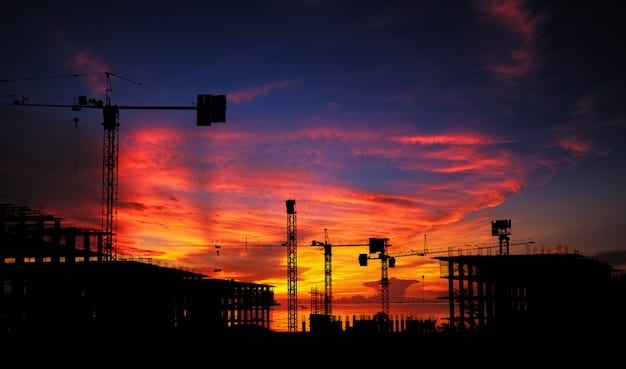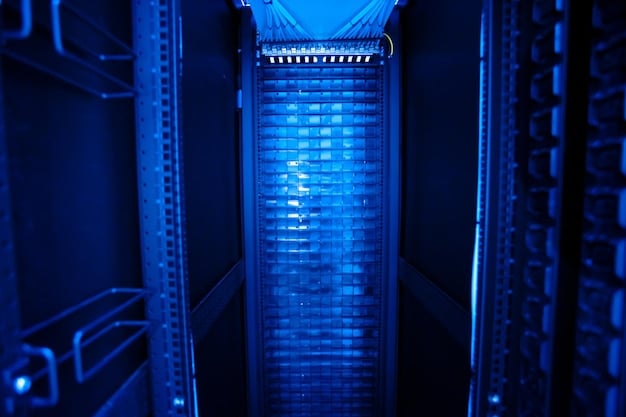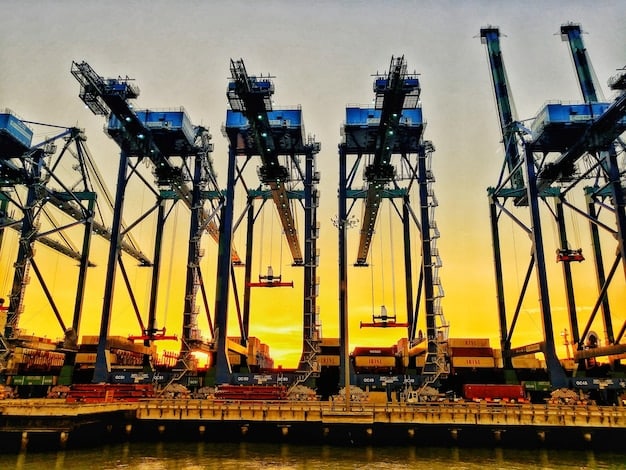Infrastructure Bill’s Impact on Key US Industries: Analysis

The proposed Infrastructure Bill is poised to significantly reshape the economic landscape of key U.S. industries, driving substantial investment in critical sectors and presenting both opportunities and challenges for businesses nationwide.
In the evolving landscape of American economic policy, few legislative proposals carry the transformative potential of a comprehensive infrastructure bill. For businesses across the nation, understanding The Impact of the Proposed Infrastructure Bill on Key Industries: A Business News Analysis is not merely an academic exercise, but a strategic imperative. This pivotal legislation, designed to modernize the country’s aging infrastructure, promises to ripple through various sectors, creating both unprecedented opportunities and necessitating significant adaptations in corporate strategy and operational execution.
The Foundations: Understanding the Infrastructure Bill’s Core
The proposed Infrastructure Bill represents one of the most substantial federal investments in American infrastructure in decades. At its core, the legislation aims to address long-standing deficiencies in transportation, utilities, broadband, and environmental resilience, laying a crucial groundwork for future economic growth and competitiveness.
Historically, infrastructure spending has been a bipartisan aspiration, albeit often bogged down by funding and prioritization debates. This current bill seeks to overcome these hurdles by allocating significant capital to projects deemed essential for national economic health and public welfare. It’s a macroscopic vision, designed to touch nearly every facet of American life and commerce.
Key Pillars of Investment
The bill’s vast scope can be broken down into several primary investment categories, each targeting specific areas of infrastructural decay or modernization needs. These pillars are not isolated; their impacts are often interconnected, creating a cascading effect across industries.
- Transportation Networks: Billions are earmarked for roads, bridges, public transit, railways, ports, and airports. This includes repair, maintenance, and the development of new, more efficient systems.
- Utilities and Water Systems: Significant funding is allocated to upgrade aging water pipes, wastewater infrastructure, and expand access to clean drinking water, addressing public health and environmental concerns.
- Broadband Expansion: A critical component is closing the digital divide by investing in universal high-speed internet access, particularly in rural and underserved areas.
- Energy Grid Modernization: Investments aim to improve energy transmission, promote renewable energy sources, and enhance grid resilience against extreme weather events and cyber threats.
Each of these pillars, while distinct, contributes to the overarching goal of creating a more robust, efficient, and equitable national infrastructure. The scale of this investment means that few, if any, industries will remain untouched by its influence.
Construction and Engineering: The Immediate Beneficiaries
Unsurprisingly, the construction and civil engineering sectors stand to be the most immediate and direct beneficiaries of the Infrastructure Bill. A deluge of new projects, from monumental bridge repairs to local road upgrades, will fuel demand for labor, materials, and specialized expertise. This anticipated boom is set to reshape project pipelines and workforce planning for years to come.
Companies involved in heavy construction, general contracting, and specialized civil engineering will likely see order books swell. This isn’t just about large, established firms; smaller, regional contractors performing essential maintenance and local upgrades will also experience a significant uptick in activity. The multiplier effect of these projects will inevitably stimulate local economies as well.
Material Suppliers and Equipment Manufacturers
The increased construction activity will translate directly into soaring demand for raw materials and heavy equipment. Suppliers of steel, cement, asphalt, aggregates, and lumber will experience heightened production requirements. This demand can stimulate expansion within these industries, but also poses challenges related to supply chain resilience and price stability.
- Steel Producers: Expect robust demand for structural steel used in bridges, buildings, and transportation infrastructure.
- Cement and Concrete: Fundamental to road construction, buildings, and water systems, demand for these materials will see a considerable increase.
- Heavy Machinery: Manufacturers of excavators, bulldozers, cranes, and other construction equipment will likely see elevated sales and rental activity.
Innovation in construction methods and materials, such as green construction techniques or advanced composites, may also accelerate due to the sheer volume of projects and the bill’s potential emphasis on sustainable practices. This bill represents not just a short-term boost, but a long-term recalibration of the industry’s capacities and strategic focus.
Transportation and Logistics: Paving the Way for Efficiency
The Infrastructure Bill’s focus on modernizing transportation networks has profound implications for the transportation and logistics sectors. Improvements to roads, bridges, railways, ports, and airports are designed to streamline the movement of goods and people, reducing transit times, cutting operational costs, and generally enhancing supply chain efficiency across the board.
For trucking companies, smoother roads and fewer bottlenecks mean more efficient routes, lower fuel consumption, and reduced wear and tear on vehicles. Rail freight could see increased capacity and speed due to upgrades in tracks and signaling systems. Meanwhile, ports and airports, as critical gateways for international and domestic commerce, will benefit from expanded capacities and technological advancements, facilitating faster throughput of cargo.
Intermodal Integration and Technology Adoption
A key outcome of these investments is likely to be improved intermodal connectivity. Better linkages between different modes of transport (e.g., rail-to-truck, ship-to-rail) can optimize complex supply chains. This integration is crucial for industries reliant on timely delivery and efficient distribution, from manufacturing to retail.
- Supply Chain Optimization: Businesses can re-evaluate logistics strategies, potentially shifting modes or routes to leverage improved infrastructure.
- Automation and AI: Enhanced infrastructure may facilitate the adoption of smart transportation technologies, such as intelligent traffic management systems and autonomous vehicle testing.
- Last-Mile Delivery: Better local road networks can improve the efficiency of urban and rural last-mile delivery services, benefiting e-commerce and retail.
Ultimately, a more robust and resilient transportation infrastructure will reduce delays, mitigate risks, and enhance the predictability of supply chains, offering a significant competitive advantage to businesses able to fully leverage these improvements.

Technology and Telecommunications: Bridging the Digital Divide
The proposed Infrastructure Bill allocates substantial funds to expand high-speed internet access, particularly in rural and underserved areas. This focus positions the technology and telecommunications sectors as central players in achieving digital equity and fostering innovation. For providers, this means immense opportunities in network build-out, but also the challenge of deployment in challenging terrains.
The expansion of broadband is not just about connecting homes; it’s about enabling businesses, supporting remote work, facilitating telehealth, and powering the next generation of smart infrastructure. Telecommunication companies, particularly those involved in fiber optic deployment and 5G network expansion, will be at the forefront of this effort. This can accelerate the rollout of advanced digital services nationwide.
Software, Hardware, and Cybersecurity Demands
The build-out of new digital infrastructure will create a ripple effect, increasing demand for a wide range of technology products and services. Hardware manufacturers will see a boom in orders for networking equipment, servers, and devices. Software developers will be needed to create applications that leverage faster connectivity.
- Networking Equipment: Routers, switches, and fiber optic cables will be in high demand.
- Cloud Services: Increased connectivity will drive greater adoption of cloud-based solutions for businesses and public services.
- Cybersecurity Solutions: As more critical infrastructure becomes digitally connected, the need for robust cybersecurity measures will intensify, benefiting security software and service providers.
Beyond traditional telecom, the bill encourages the development of smart cities and intelligent transportation systems, which rely heavily on IoT (Internet of Things) devices and data analytics. This creates new markets for sensors, data platforms, and AI-driven solutions, allowing the tech sector to play a broader role in infrastructural modernization.
Energy and Utilities: A Greener, More Resilient Grid
Investments within the Infrastructure Bill targeting the energy and utilities sectors aim to modernize the antiquated energy grid, enhance its resilience, and accelerate the transition towards cleaner energy sources. For utility companies, this translates into significant capital expenditure opportunities for upgrading transmission lines, deploying smart grid technologies, and integrating renewable energy.
The bill’s emphasis on grid hardening seeks to protect against extreme weather events, cyberattacks, and other disruptions, ensuring a more reliable power supply. This involves replacing aging infrastructure, incorporating advanced materials, and implementing sophisticated monitoring systems. The goal is a grid that is not only robust but also responsive to dynamic energy demands and supply from diverse sources.
Renewable Energy and EV Infrastructure
A crucial element of the energy modernization push is the promotion of renewable energy and electric vehicle (EV) infrastructure. This will drive significant investment in solar, wind, and geothermal projects, boosting companies involved in renewable energy generation, storage, and associated technologies.
- Renewable Energy Development: Opportunities for developers and manufacturers of solar panels, wind turbines, and battery storage solutions.
- Electric Vehicle Charging Networks: Substantial funding for building out a nationwide network of EV charging stations, benefiting automotive manufacturers and energy providers.
- Smart Grid Technologies: Investments in advanced metering infrastructure, demand response systems, and grid-scale energy storage.
This shift towards a greener, more decentralized, and intelligent grid will reshape the energy landscape, creating new business models and fostering innovation in energy management and distribution. It underscores a long-term commitment to sustainability and energy independence.
Manufacturing and Supply Chains: Adaptations and Opportunities
While not direct recipients of infrastructure funding, the manufacturing sector and complex global supply chains will experience significant indirect impacts from the proposed bill. Improved domestic infrastructure can reduce logistics costs for manufacturers, enhance their competitiveness, and potentially lead to a resurgence in domestic production.
Smoother supply routes, reliable energy, and expanded broadband access underpin a more efficient manufacturing process. Companies can reduce lead times, optimize inventory management, and better serve their customer bases through a more predictable logistical environment. This could incentivize “re-shoring” or “near-shoring” of production capabilities, reducing reliance on distant and potentially volatile overseas supply chains.
Resilience, Localization, and Digital Integration
The pandemic exposed vulnerabilities in global supply chains, prompting a push for greater resilience and localization. The Infrastructure Bill’s domestic focus aligns with this trend, providing the physical and digital backbone for more robust internal networks. Manufacturers may find it more advantageous to source materials and components domestically, supported by improved transport and connectivity.
- Domestic Sourcing: Enhanced infrastructure supports local suppliers and reduces risks associated with international shipping.
- Leaner Inventory: Improved logistics can allow manufacturers to operate with just-in-time inventory systems more effectively.
- Industry 4.0 Adoption: Better broadband and energy infrastructure facilitate the deployment of smart manufacturing technologies, automation, and data analytics on factory floors.
The intersection of infrastructural improvements with advanced manufacturing techniques promises to create a more agile, responsive, and competitive industrial base. This isn’t just about moving goods; it’s about transforming how goods are made and distributed across the nation.

Real Estate and Urban Development: Shifting Landscapes
The Infrastructure Bill will inevitably influence the real estate and urban development sectors, albeit with complex and varied outcomes. Investments in public transit, water systems, and broadband can boost property values and spur development in previously underserved areas, while large-scale construction projects may also lead to temporary disruptions.
Areas benefiting from new or upgraded transportation hubs, improved utility services, and enhanced digital connectivity often experience increased desirability for both residential and commercial development. This can lead to urban revitalization, the growth of suburban centers, and the emergence of new economic corridors, especially along upgraded transportation routes.
Zoning, Permitting, and Long-Term Trends
Local zoning laws and permitting processes will play a crucial role in how quickly and effectively infrastructure investments translate into real estate development. Developers will need to navigate these local specificities while capitalizing on broader trends of improved accessibility and public services.
- Transit-Oriented Development: Growth around new or upgraded public transit lines will likely accelerate, creating walkable, mixed-use communities.
- Remote Work Enablers: Broadband expansion in rural areas could make remote work more viable, potentially shifting population distribution and real estate demand.
- Waterfront Revitalization: Investments in water infrastructure and climate resilience can open up new opportunities for development in coastal or flood-prone areas, albeit with new engineering challenges.
The long-term impact on real estate will depend on how effectively communities leverage these foundational improvements to attract businesses and residents, balancing development with environmental and social considerations. Careful planning and public-private partnerships will be key to unlocking the full potential of these infrastructure investments in the built environment.
| Key Impact | Brief Description |
|---|---|
| 🏗️ Construction Boom | Direct increase in projects for roads, bridges, and utilities, boosting demand for labor and materials. |
| 🚚 Logistics Efficiency | Improved transportation networks to lower costs and speed up supply chains for all industries. |
| 🌐 Digital Expansion | Significant investment in broadband closes the digital divide, benefiting tech and remote work. |
| ⚡ Grid Modernization | Upgrades to the energy grid support renewables and enhance reliability, impacting utilities and energy sectors. |
Frequently Asked Questions
▼
The primary goal is to significantly modernize and improve the United States’ aging infrastructure across various sectors, including transportation, utilities, broadband, and energy. It aims to boost economic competitiveness, create jobs, and enhance the quality of life for Americans by ensuring reliable and efficient foundational services.
▼
The construction and civil engineering sectors are expected to be the most immediate beneficiaries due to increased project demand. Additionally, manufacturers of construction materials and heavy equipment, as well as technology and telecommunications companies involved in broadband rollout, will see significant direct positive impacts.
▼
Improvements to roads, bridges, railways, ports, and airports will lead to enhanced efficiency in goods movement, reduced transit times, and lower operational costs for trucking, rail, and shipping companies. This will optimize supply chains, making them more resilient and predictable for businesses across all sectors.
▼
The bill aims to modernize the energy grid, making it more resilient and supporting the transition to clean energy. This includes funding for renewable energy projects, smart grid technologies, and the expansion of electric vehicle charging infrastructure, creating opportunities for utility companies and green tech firms.
▼
Yes, industries like manufacturing will benefit from reduced logistics costs, improved domestic supply chain reliability, and enhanced digital capabilities. Real estate and urban development could see increased property values and new growth opportunities in areas with upgraded infrastructure, leading to broader economic ripple effects.
Conclusion
The proposed Infrastructure Bill represents more than just a federal spending package; it is a foundational investment poised to redefine the operational landscape for key industries across the United States. From the immediate boom in construction and engineering to the long-term efficiencies gained in transportation and logistics, and the transformative expansion of digital and energy infrastructure, its multifaceted impacts are undeniable. Businesses that proactively analyze these shifts, adapt their strategies, and embrace the opportunities presented will be best positioned to thrive in the modernized American economy. The ripple effect of this legislation will ensure that its influence extends far beyond the construction sites, touching every aspect of American business and daily life for decades to come.





